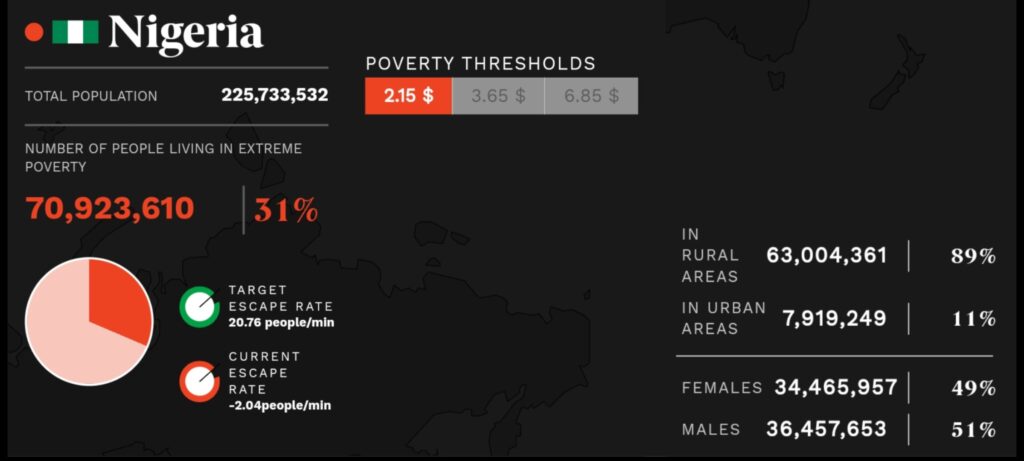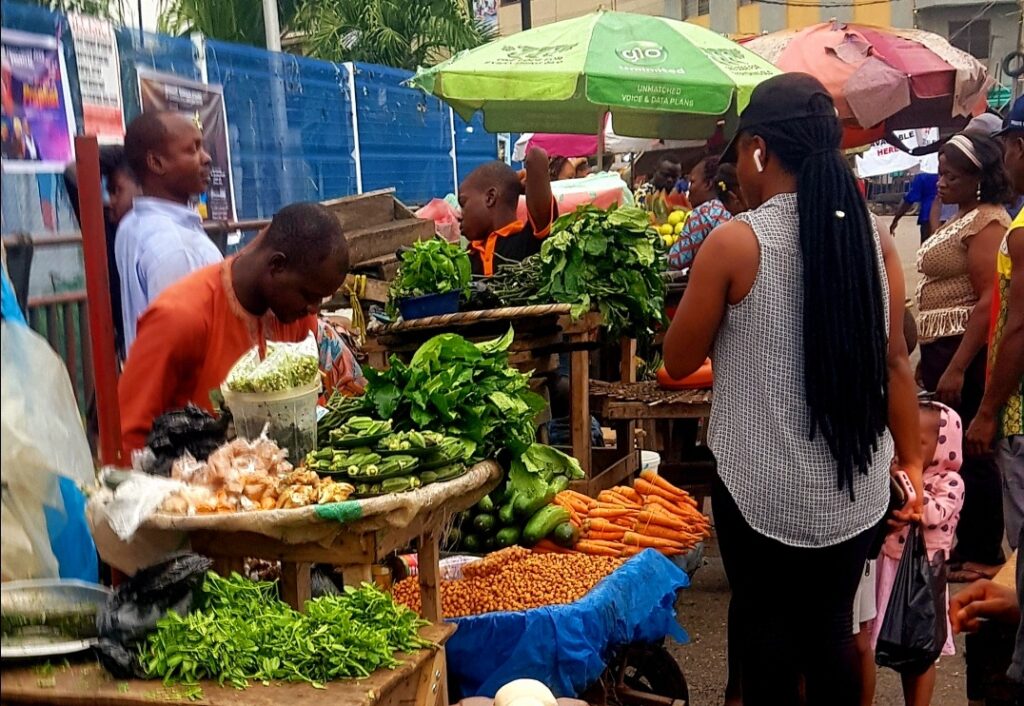‘Eat More Protein, Avoid Processed Snacks and Fast Food,’ Experts Advice 26.6 Million Nigerians with Poor Nutritional Habits
Nigeria stands at a critical juncture, where concerted efforts are essential to alleviate hunger and protect its most vulnerable citizens. Conflict, insecurity, rising inflation, and the climate crisis have converged to create a dire situation in Nigeria. According to projections, a staggering 26.5 million people across the country are expected to face acute hunger during the June-August 2024 lean season. This represents a significant increase from the 18.6 million people who were already food insecure at the end of 2023.
Children are particularly vulnerable to food insecurity. Approximately 6 out of the 17 million food-insecure Nigerians are children under 5 years old, residing in states like Borno, Adamawa, Yobe, Sokoto, Katsina, and Zamfara. Acute malnutrition poses a serious risk to their survival. In the BAY states alone, the number of children suffering from acute malnutrition is expected to rise from 1.74 million in 2022 to 2 million in 2023.
Nigeria’s future hangs in the balance, waiting for a chorus of voices to rise and rewrite its story. In this special feature on development communications strategies to address these issues, LightRay! Media’ Editor-in-Chief, Ejiro Umukoro and correspondent Collins Odigie Ojiehanor look at the issues, the drivers and immediate solutions.
As Nigeria pursues its quest to feed the future, a stark reality check awaits. The country’s agricultural sector, once the backbone of its economy, has suffered a decline in recent years. The focus on oil and gas resources has overshadowed the importance of food security, leaving peasants – the majority of Nigeria’s farmers – without the necessary capital, skills, and supplies to produce food in sufficient quantities.
The consequences are dire. Food insecurity is on the rise, with Nigeria’s population of over 200 million people outpacing local food production. The average household spends a significant portion of their income on food, with transportation costs adding to the burden.
“The situation is alarming,” says Dr. Adeyemi Olukayode, a nutrition expert at the University of Lagos. “Malnutrition is a silent killer, and we’re seeing its effects in the rising cases of dietetic diseases like diabetes, hypertension, and stunted growth in children.”
Statistics paint a grim picture:
- Over 60% of Nigerians live below the poverty line, struggling to access nutritious food.
- The country’s food import bill stands at $3.2 billion annually, a significant drain on foreign exchange earnings.
- Agricultural productivity has declined by 15% in the past five years, exacerbating food insecurity.
“I spend almost half of my salary on food alone,” says Mrs. Nkechi Okoro, a civil servant. “It’s hard to make ends meet, and I worry about the nutritional value of the food I can afford.”
As Nigeria grapples with the challenges of feeding its teeming population, it’s clear that the nutritional crisis is a ticking time bomb. The government must prioritize agricultural development, support local farmers, and address the root causes of food insecurity.
“The future of Nigeria’s food security depends on it,” warns Dr. Olukayode. “We must act now to avoid a catastrophic crisis that will affect generations to come.”
The quest to feed the future is a noble one, but Nigeria must first address the nutritional crisis staring it in the face.
The Perfect Storm: Drivers of Food Insecurity
- Conflict and Violence: Persistent violence in the north-eastern states of Borno, Adamawa, and Yobe (BAY) has disrupted food access. Additionally, armed banditry and kidnapping in states like Katsina, Sokoto, Kaduna, Benue, and Niger further exacerbate the situation.
- Climate Change Impact: Widespread flooding in the 2022 rainy season damaged over 676,000 hectares of farmland, reducing harvests and increasing the risk of food insecurity. These extreme weather patterns are linked to climate change and variability in Nigeria.
- Inflation and Rising Food Prices: Soaring inflation rates have made food less affordable for vulnerable households.
Addressing the Crisis
UNICEF, in collaboration with the government and partners such as MSF and ALIMA, is scaling up preventive nutrition interventions. Efforts are focused on ensuring vulnerable children have access to life-saving nutrition services. In 2022, UNICEF reached approximately 650,000 children with critical nutrition support across the six affected states. However, urgent action is needed to prevent further deterioration of the situation.
The Role of Agricultural Policies and Programs
Policy Instability and Implementation Challenges
Nigeria’s agricultural sector faces significant challenges due to frequent policy changes and poor implementation of existing programs. Each time a new government assumes power, previous agricultural policies and programs are abandoned, and new ones are introduced. Unfortunately, this cycle often lacks transparency and accountability, undermining the intended benefits for farmers and food security.
Transparency and Accountability
To address this, there’s an urgent need for transparent and accountable governance. Agricultural policies should be evidence-based, incorporating input from experts, farmers, and relevant stakeholders. Additionally, monitoring mechanisms must ensure that resources allocated to agriculture reach the intended beneficiaries without being siphoned off by corruption.

Poverty and Nutrition Challenges
Economic Struggles and Resource Disparities
The economic reality in Nigeria is harsh for many citizens. With a minimum wage of approximately ₦30,000, not even paid by many states, a significant portion of the population earns below the threshold necessary to meet basic living standards. Soaring inflation rates and a lack of affordable housing further exacerbate poverty.
Nigeria’s Silent Crisis: Poverty, Nutrition, and the Struggle for Survival
According to the World Poverty Clock, a global poverty model meticulously tracking progress against ending extreme poverty, Nigeria’s population of 225,733,532 harbors a staggering truth: 31% of Nigerians—approximately 70,923,610 individuals—live in extreme poverty. Their daily existence hinges on surviving with less than $2.15 per day, a meager sum that must cover basic needs like food, shelter, and healthcare.
Urban vs. Rural Divide
The distribution of extreme poverty paints a stark picture. In the rural heartlands, where vast expanses of green meet the horizon, 89% of the population—63,004,361 people—struggle to escape the clutches of destitution. These are the forgotten villages, where subsistence farming and hand-to-mouth existence define daily life.
Yet, in the bustling urban centers—where skyscrapers scrape the sky and neon lights beckon—the story is different. Here, 7,919,249 individuals—comprising 11% of the population—battle the same demons. The city streets echo with their silent cries, drowned out by the cacophony of progress.
The Cost of Living: A Cruel Equation
Dr. Chioma Amaechi, an economist with unwavering resolve, stands at the intersection of poverty and nutrition. Her words cut through the noise: “The high cost of living relative to income levels poses a severe challenge to food security and nutritional health among Nigerians.” She knows the equation well: low incomes, rising prices, and devastating consequences.
Despite efforts to set a minimum wage, many earners fall short of meeting their basic needs. Accessing nutritious food becomes a privilege, not a right. The cycle of malnutrition takes root, gnawing at the foundations of overall health.

Unequal Resources, Widespread Malnutrition
Dr. Amaechi’s insights delve deeper. Economic disparities and unequal resource distribution amplify the struggles faced by vulnerable populations. When income cannot stretch to afford nutritious diets, compromise becomes inevitable. Children and pregnant women bear the brunt—widespread malnutrition threatens their futures.
But hope glimmers. Dr. Amaechi advocates for strategic investments: healthcare infrastructure and nutrition education. These are the tools to break the cycle of poverty and malnutrition, paving the way for a healthier, more prosperous Nigeria.
Maryann Udoka’s Reality Check
Maryann Udoka, a communications specialist, pulls no punches. “In Nigeria, the cost of living outpaces current income levels,” she declares. The math is brutal: many Nigerians earn below their cost of living. Poverty becomes their unwelcome companion, a shadow that lengthens with each passing day.
The minimum wage—around ₦30,000—barely scratches the surface. The average monthly salary—₦140,000—remains elusive for countless earners. Basic needs—food, housing, healthcare—slip through their fingers. The uneven distribution of resources and wealth compounds their struggle, leaving them teetering on the precipice.
A Call for Comprehensive Policies
Udoka’s prescription is clear: comprehensive economic and social policies. Elevate income levels, ensure equitable access to resources. Perhaps it’s time to recalibrate the minimum wage, bridging the gap between survival and thriving. Or perhaps affordability—of food, healthcare, and housing—holds the key.
As the sun sets over Nigeria’s diverse landscape, the nation grapples with its silent crisis. Poverty and nutrition intertwine, shaping destinies. The path forward lies in collective action, in policies that uplift the vulnerable and pave the road to prosperity.
Nigeria’s Silent Crisis: Poverty, Nutrition, Health Hazards and the Burden of Foodborne Illnesses
The World Health Organization (WHO) sounds the alarm: Africa bears the highest burden of foodborne diseases per population, and Nigeria plays a significant role in this crisis. Contaminated food leads to countless cases of illness and death, disproportionately affecting vulnerable groups such as children and the elderly.
Obesity and Diabetes on the Rise
In the bustling urban centers, a silent epidemic unfolds. A 2020 study published in the journal “Frontiers in Public Health” reveals an alarming trend: obesity rates are surging, particularly among women. In some regions, up to 20% of the population grapples with excess weight, risking their health.
The International Diabetes Federation (IDF) estimates that in 2021, approximately 3.6 million Nigerians lived with diabetes, with many cases undiagnosed. Among adults aged 20-79 years, the prevalence of diabetes stands at 3.1%, and the annual toll of diabetes-related deaths reaches 40,800.
Hypertension and Cardiovascular Burden
The Nigeria Hypertension Society (NHS) paints a grim picture: 30% of Nigerian adults battle hypertension. A 2018 study in the “Journal of the American College of Cardiology” reveals that awareness, treatment, and control rates for hypertension are 30%, 24%, and 10%, respectively. Cardiovascular diseases (CVDs) account for 11% of total deaths in Nigeria, according to the WHO.
The rising prevalence of hypertension, obesity, and diabetes significantly contributes to the mounting burden of CVDs, silently claiming lives across the nation.
Economic Constraints and Malnutrition
Dr. Bukola Adeyemi, a nutrition expert, sheds light on the gravity of the situation. Economic constraints force Nigerians into various forms of malnutrition—from undernourishment to obesity—as they make unhealthy dietary choices. She introduces the concept of “Hidden Hunger,” where individuals may appear healthy but lack crucial vitamins and minerals, posing significant health risks.
“In these tough times,” Dr. Adeyemi explains, “many people will face various cases of malnutrition because they cannot afford the ever-increasing cost of food.” Some become undernourished, lacking essential nutrients for normal bodily function. Others veer toward overweight, opting for cheap, junk foods over nutritious options.
Dangers of Poor Diets
Dr. Adeyemi issues a warning: “Buying foods high in sodium and saturated fat can lead to obesity. This increases the risk of non-communicable diseases like diabetes and hypertension because people are not eating healthily.” She also addresses “Hidden Hunger,” emphasizing that seemingly healthy individuals—especially pregnant women and nursing mothers—may suffer from anemia due to essential vitamin deficiencies (like iron and vitamin A).

Meeting Nutritional Needs
Despite challenges, Dr. Adeyemi emphasizes striving to meet nutrient requirements. “Even in tough times,” she advises, “look for alternative protein sources if you cannot afford meat or fish. Incorporate fruits—even in small amounts—despite their cost.”
Future Outlook and Sustainable Solutions
In response to rising nutritional crises and dietary diseases, experts advocate sustainable solutions for a healthier Nigeria. These integrated efforts address immediate challenges while laying a foundation for improved health outcomes. Dr. Adeyemi shares insights:
“A healthy future is possible with good food—nutritious and wholesome,” she asserts. “Cut down on soda and low-nutrition foods. Opt for wholesome grains and rice over polished options. Avoid refined snacks.”
Dr. Adeyemi underscores the importance of protein-rich foods and natural oils. “Choose olive oil over saturated oils,” she advises. “Include nutrient-dense foods like avocados, nuts, and grains—even if they’re expensive. They contribute to a good and happy life.”
Long-term benefits await those who eat right. “Avoid junk food,” Dr. Adeyemi concludes. “It can significantly reduce disease risk. Eating right is the best preventative measure—even for those genetically predisposed.”
Nigeria’s path to health lies in informed choices and sustainable practices.
The Lifespan Equation: Eating Right Matters
Unhealthy food isn’t merely a fleeting indulgence; it’s a silent saboteur. Someone genetically predisposed to heart disease can alter their fate. By making wise dietary choices from a young age, they can delay the onset of such diseases until much later in life. Eating right becomes their best preventative measure—a lifeline to longevity.

For Nigeria’s long-term sustainability and improved health outcomes, key initiatives must take root. Integrated nutrition programs hold the key. These programs, designed to educate and empower communities, focus on balanced diets and nutritional needs. Their bullseye? Vulnerable groups—children and pregnant women.
Strengthened by partnerships with local healthcare providers and community leaders, these programs disseminate knowledge on diverse, nutritious food options. They’re more than information; they’re lifelines woven into the fabric of communities.
Food Security and Infrastructure: A Vital Connection
Policymakers, take heed. The link between food security and nutrition is unbreakable. To fortify this connection, invest in infrastructural improvements. Strengthen storage facilities, weave robust transportation networks, and widen market access. Why? To ensure consistent availability of affordable, nutritious food products.
But there’s more: promote dietary diversity among local farmers. Incentivize the cultivation of nutrient-rich crops. This dual approach not only nourishes communities but also bolsters economic resilience within agricultural hubs.
Healthcare at the Core: Nutritional Counseling and Screening
Picture a Primary Health Care (PHC) facility. Now envision it enhanced—infused with nutritional counseling and early screening for dietary diseases. Empower individuals to make informed health choices. Let community engagement initiatives flourish, nurturing nutrition programs at the grassroots level. These programs? Seeds of sustainable practices and healthier lives.
Labels, Monitoring, and Real-Time Adaptation
Regulatory frameworks matter. Strengthen them. Improve food labeling and marketing practices. Ensure consumers access accurate nutritional information. But don’t stop there. Establish robust monitoring and evaluation mechanisms. Track progress. Optimize resource allocation. Adapt strategies based on real-time data.
Nigeria’s path to health isn’t a solitary journey; it’s a collective commitment.





Comments